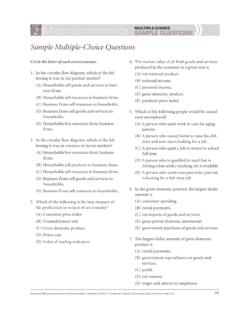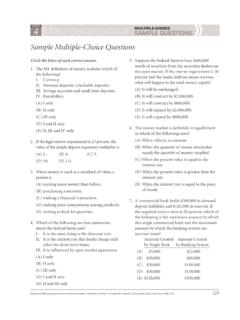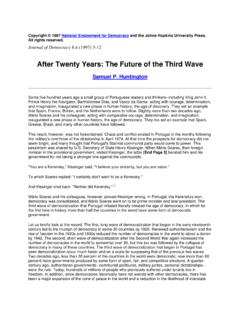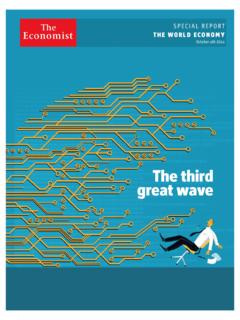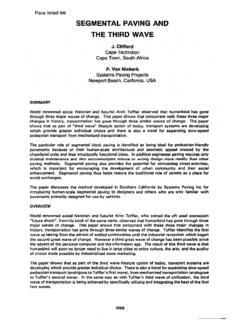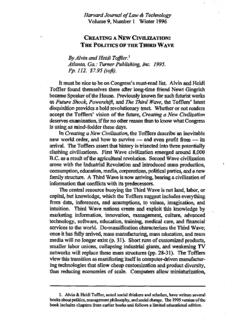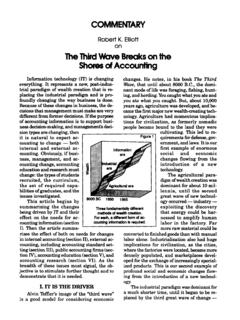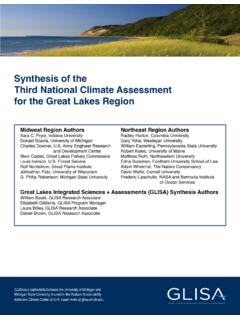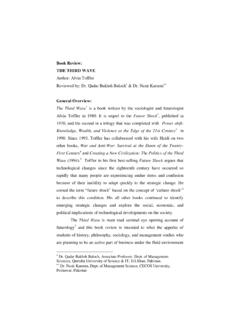Transcription of The Classical Era in World History: The Big Picture 500 B ...
1 The Classical Era in World history : The Big Picture 500 500 C. Robert W. Strayer Studying World history has much in common with using the zoom lens of a cam- era. Sometimes, we pull the lens back in order to get a Picture of the broadest possible panorama. At other times, we zoom in a bit for a middle-range shot, or even farther for a close-up of some particular feature of the historical landscape. Students of World history soon become comfortable with moving back and forth among these several perspectives. As we bid farewell to the First Civilizations, we will take the opportunity to pull back the lens and look broadly, and briefly, at the entire age of agricultural civilizations, a period from about 3500 , when the earliest of the First Civilizations arose, to about 1750 , when the first Industrial Revolution launched a new and distinctively modern phase of World history .
2 During these more than 5,000 years, the most prominent large-scale trend was the globalization of civilization as this new form of human community increasingly spread across the planet, encompassing more people and larger territories. The first wave of that process, addressed in Chapter 3, was already global in scope, with expressions in Asia, Africa, and the Americas. Those First Civilizations generated the most impressive and powerful human societies created thus far, but they proved fragile and vulnerable as well. The always-quarreling city-states of ancient Mesopotamia had long ago been absorbed into the larger empires of Babylon and Assyria.
3 During the first millennium , Egypt too fell victim to a series of foreign invaders, including the forces of Nubia, Assyria, Alexander the Great, and the Roman Empire. The Indus Valley civilization likewise declined sharply, as deforestation, topsoil erosion, and decreased rainfall led to desertification and political collapse by 1500 Norte Chico civilization seems to have faded away by 1800 The end of Olmec civilization around 400 has long puzzled historians, for it seems that the Olmecs themselves razed and then abandoned their major cities even as their civilizational style spread to neighboring peoples. About the same time, China s unified political system fragmented into a series of warring states.
4 Even if particular First Civilizations broke down, there was no going back. Civilization as a form of human community proved durable and resilient as well as periodically fragile. Thus, in the thousand years between 500 and 500 , new or enlarged urban-centered and state-based societies emerged to replace the First Civilizations in the Mediterranean basin, the Middle East, India, China, Mesoamerica, and the Andes. Furthermore, smaller expressions of civilization began to take shape elsewhere in Ethiopia and West Africa, in Japan and Indonesia, in Vietnam and Cambodia. In short, the development of civilization was becoming a global process.
5 Many of these second wave civilizations likewise perished, as the collapses of the Roman Empire, Han dynasty China, and the Mayan cities remind us. They were followed by yet a third wave of civilizations (roughly 500 to 1500 ; see Part Three). Some of them represented the persistence or renewal of older patterns, as in the case of China, for example, while elsewhere such as in Western Europe, Russia, Japan, and West Africa new civilizations emerged, all of which borrowed heavily from their more-established neighbors. The largest of these, Islamic civilization, incorporated a number of older centers of civilization, Egypt and Mesopotamia for example, under the umbrella of a new religion.
6 The globalization of civilization continued apace. The size and prominence of these civilizations sometimes lead historians and history textbooks to ignore those cultures that did not embrace the city and state centered characteristic of civilizations. World history , as a field of study, has often been slanted in the direction of civilizations at the expense of other forms of human community. To counteract that tendency, the following chapters will, on occasion, point out the continuing historical development of gathering and hunting peoples, agricultural societies organized around kinship principles and village life, emerging chiefdoms, and pastoral peoples.
7 Continuities in Civilization The renewal and expansion of civilization, however, remains the leading story. As this account of the human journey moves into the second and third waves of civilization, the question arises as to how they differed from the first ones. From a panoramic perspective, the answer is not much. States and empires rose, expanded, and collapsed with a tiresome regularity, requiring history students to remember who was up and who was down at various times. It is arguable, however, that little fundamental change occurred amid these constant fluctuations. Monarchs continued to rule most of the new civilizations; men continued to dominate women; a sharp divide between the elite and everyone else persisted almost everywhere, as did the practice of Furthermore, no technological or economic breakthrough occurred to create new kinds of human societies as the Agricultural Revolution had done earlier or as the Industrial Revolution would do in later centuries.
8 Landowning elites had little incentive to innovate, for they benefited enormously from simply expropriating the surplus that peasant farmers produced. Nor would peasants have any reason to invest much effort in creating new forms of production when they knew full well that any gains they might generate would be seized by their social superiors. Merchants, who often were risk takers, might have spawned innovations, but they usually were dominated by powerful states and were viewed with suspicion and condescension by more prestigious social groups. Many fluctuations, repetitive cycles, and minor changes characterize this long era of agricultural civilization, but no fundamental or revolutionary transformation of social or economic life took place.
9 The major turning points in human history had occurred earlier with the emergence of agriculture and the birth of the First Civilizations and would occur later with the breakthrough of industrialization. Changes in Civilization While this panoramic perspective allows us to see the broadest outlines of the human journey, it also obscures much of great importance that took place during the second and third waves of the age of agrarian civilization. If we zoom in a bit more closely, significant changes emerge, even if they did not result in a thorough transformation of human life. Population, for example, grew more rapidly than ever before during this period, as the Snapshot illustrates.
10 Even though the overall trend was up, important fluctuations interrupted the pattern, especially during the first millennium , when no overall growth took place. Moreover, the rate of growth, though rapid in comparison with Paleolithic times, was quite slow if we measure it against the explosive expansion of recent centuries, when human numbers quadrupled in the twentieth century alone. This modest and interrupted pattern of population growth during the age of agrarian civilization reflected the absence of any fundamental economic breakthrough, which could have supported much larger numbers. Another change lies in the growing size of the states or empires that structured civilizations.







